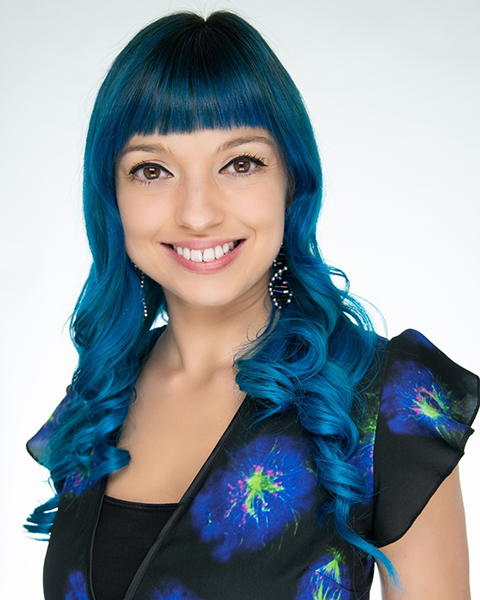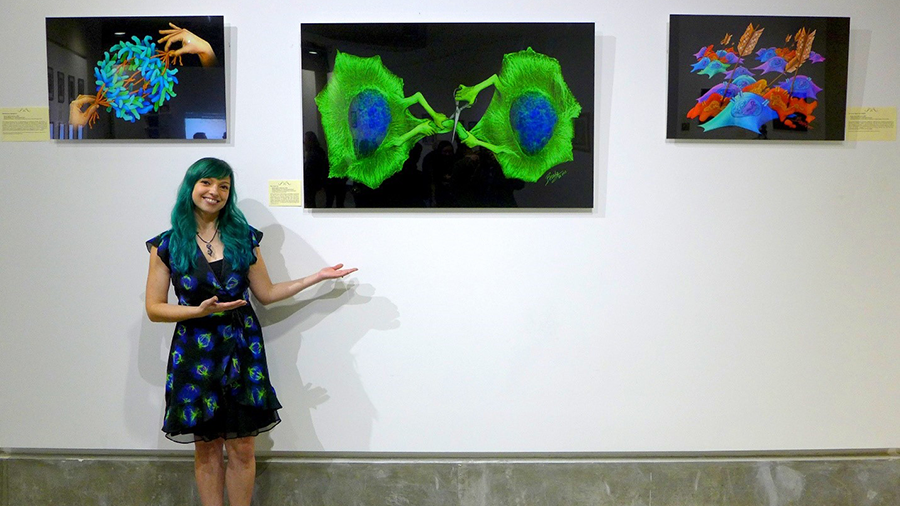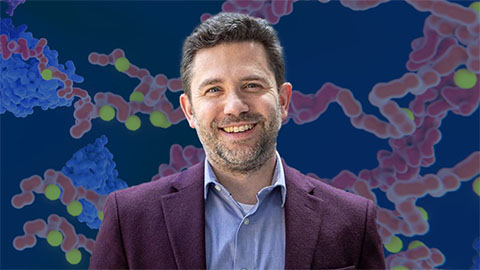A molecular biologist by day and a science artist by night
Beata Mierzwa is a postdoctoral researcher at the Ludwig Institute for Cancer Research at the University of California, San Diego. She is also an artist with a growing science art brand.
At the bench in the labs of Karen Oegema and Arshad Desai, Mierzwa studies cell-division machinery.
“I use genomewide CRISPR screens to discover new genes that are essential for these cell type-specific divisions,” she said. “Uncovering such genes has the potential to identify new targets for cancer therapy, opening up new and exciting avenues to treat cancer in the future.”

Through her brand, Beata Science Art, she creates illustrations for other scientists and research groups, including journal covers and art for scientific presentations.
“One thing that I really enjoy about making drawings and illustrations for other people is that it doesn’t really feel like I get disconnected from science,” she said. “I read a lot of scientific papers … and learn about all the amazing discoveries that are being made right now.”
Using science as a tool to create art
Mierzwa was born in Poland and grew up in Austria. Her mother, who works as a makeup artist at an opera company in Vienna and creates oil paintings, taught her how to draw and paint. Her father repaired electronic devices professionally and now does engineering projects, such as building a 3D printer from scratch, on the side.
In high school, Mierzwa enjoyed crafting and learned how to sew her own clothes. But, she said, she did not know she could combine science and art in a career, so she focused solely on science.
While she was earning her combined bachelor’s and master’s degree in molecular biology from the University of Vienna, she interned at several laboratories. She finished her master’s thesis at the ETH Zürich in Switzerland in Daniel Gerlich’s laboratory and continued working in his group at the Institute of Molecular Biotechnology in Austria, where she earned her Ph.D. in molecular biology.
While working on her Ph.D., she noticed the beauty of cell division under a microscope and wanted to find a way to incorporate art into her work.
With support from her group leader and the communications department at her institute, she began working on art projects in her spare time in 2013 and recognized that art is a powerful tool for science communication.
As a scientist, she said, “Traditionally, the only kind of value you get from your scientific work is publications. Science communication is just as important; it’s just not measured the same way.”
She started Beata Science Art to create scientific illustrations and science-inspired clothing. She said she aims to show the beauty of cell division and communicate science across audiences.
“My biggest science art inspirations are Ahna Skop and David Goodsell, both of whom have been pioneers in bringing together art and science throughout their careers,” she said. “I also admire the artists M.C. Escher and Vladimir Kush, who create surreal worlds through fusing seeming unrelated elements and imagery.”
In 2017, she opened her Etsy store, which has had more than 1,300 sales and is a top-rated shop for gifts, with five out of five stars. Her best-selling items are science-themed face masks, specifically her cell-division microscopy images and drawings of chromosome segregation designs. She also sells scarves, ties, art prints and science jewelry crafting kits.
For fashions, she uses images from the microscope to create patterns to print on fabric. She said she is learning how to draw on a tablet and create animations.
“Once I started sharing my art online, people were reaching out to me — authors who want to submit a cover for their accepted manuscripts, editors from scientific journals or research groups who want to illustrate their research. Most of my commissions are drawings for journal covers that illustrate specific research papers, but sometimes I get other exciting requests too (like space mission patches or award medals). I love the variety of projects and that I get to learn something new every time,” she said.

Illustrating research for clients
During the day, Mierzwa works in the lab doing experiments or data analysis (due to the pandemic, she is doing more computational work). Then, in the evenings and on weekends, she works on other projects including art and outreach.
Clients generally contact her via email for commission projects, and they discuss a timeline that will work so she can create the science art to meet their needs.
Research is the first step in any art project Mierzwa tackles. She begins by learning about the topic in order to determine the best way to illustrate the core findings. Usually, the client sends her a manuscript to read.
After making a detailed pencil drawing on paper, she takes a high-resolution scan of the drawing and then adds the colors digitally.
So far, she has made covers for the EMBO Journal, Nature Genetics, and Molecular Biology Evolution. (See them in the gallery section of her website.)
Also, she recently presented her work at the 11th International Meeting on Visualizing Biological Data at the University of Southern California Bridge Institute.
Looking into the future
Along with using art to communicate science, one of Mierzwa’s goals is to make science accessible to all, especially young girls.
She is an ambassador for the American Association for the Advancement of Science IF/THEN Initiative and vice chair of Young Women in Bio–Southern California and works with girls who are interested in science careers.
She recently released the preview of a science-themed video game that she designed. Called Microscopya, the game helps the player understand the inside of the cell. This project is funded by a grant from the AAAS IF/THEN Initiative and the American Society for Cell Biology COMPASS Outreach Grant.
“In a perfect world, I would absolutely love to continue doing both science and art … I cannot imagine stopping either of them. We will see what the future brings,” she said.
To find out more about Beata Mierzwa’s work, check out her website or follow her on Twitter.
Enjoy reading ASBMB Today?
Become a member to receive the print edition four times a year and the digital edition monthly.
Learn moreFeatured jobs
from the ASBMB career center
Get the latest from ASBMB Today
Enter your email address, and we’ll send you a weekly email with recent articles, interviews and more.
Latest in People
People highlights or most popular articles

Bibel named assistant professor
She began her position at Loyola Marymount University in August 2025.

Unraveling the language of histones
Philip Cole presented his research on how posttranslational modifications to histones are involved in gene expression and how these modifications could be therapeutically targeted to treat diseases like cancer.

Cotruvo named Blavatnik award finalist
He received a $15,000 prize and was honored at a gala in October.

Phosphatases and pupils: A dual legacy
Yale professor Anton Bennett explores how protein tyrosine phosphatases shape disease, while building a legacy of mentorship that expands opportunity and fuels discovery in biochemistry and molecular biology.

Summer research spotlight
The 2025 Undergraduate Research Award recipients share results and insights from their lab experiences.

Truttmann recognized for cell stress research
He was honored by the Cell Stress Society International for his work on heat shock protein 70.

